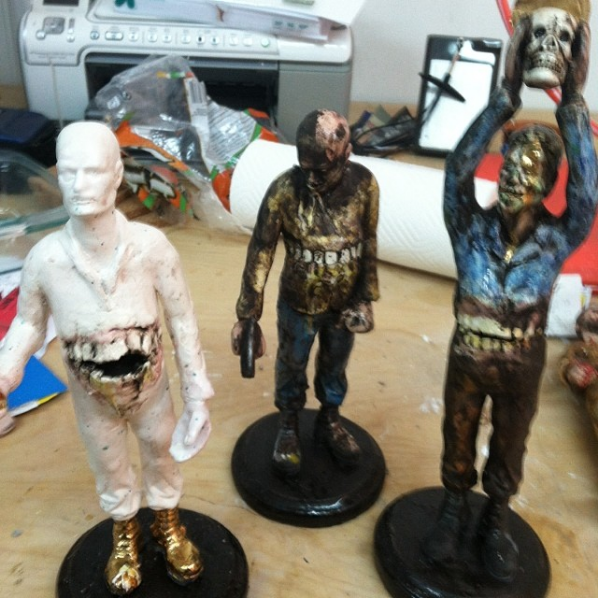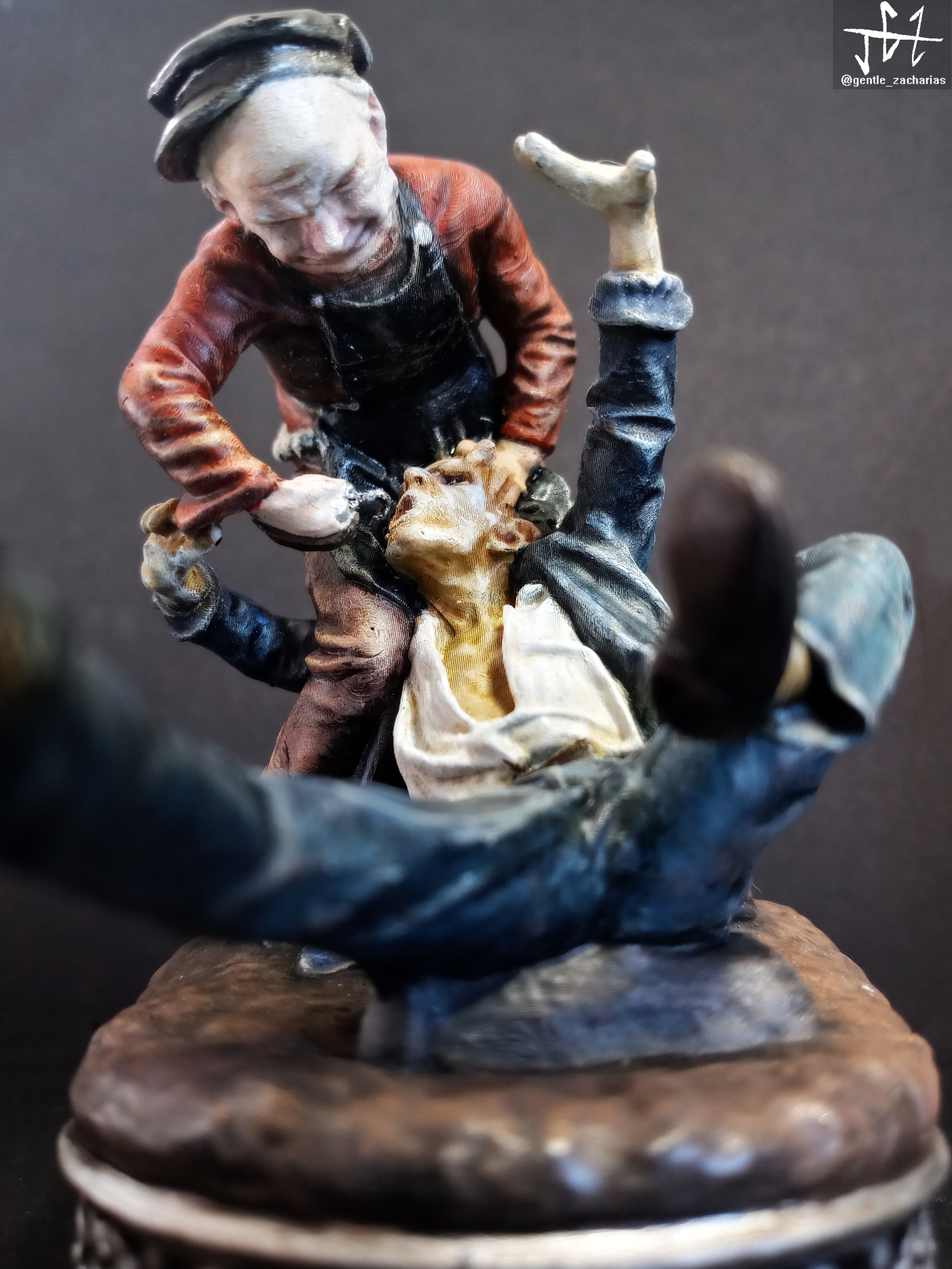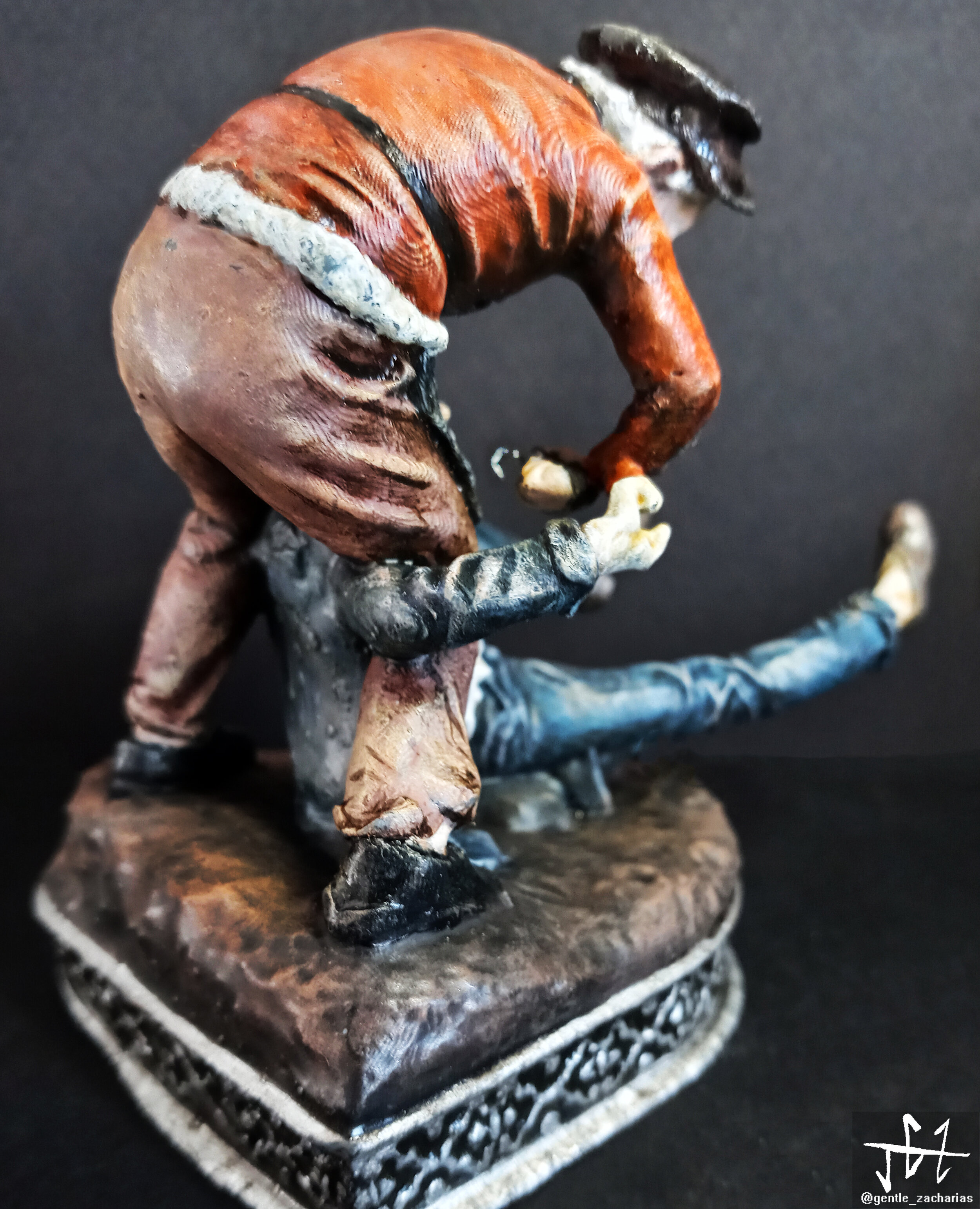The Blacksmith Dentist
I guess since you’re here, you’ve demonstrated an ability to appreciate the kind of macabre stuff I tend to enjoy. Not everybody gets it. But I come by it honest! My aesthetic pedigree was none of my doing, but it had a very specific bent.
My stepfather sculpts in ceramic and draws album covers for black metal bands. He's always done a lot of teeth, for some reason - we all have our artistic obsessions.
This lives on the bathroom counter at my parents’ house:
It's a vintage dentist's model from the early 20th century. This one belonged to my maternal great-grandfather, Dr. Small, who was a maritime dentist in New England around that time. It's funny, the career didn't run in the family - we're all fluffy, arty weirdos, no doctors here - but the dental fixation apparently did. I know I seem morbid by comparison with normal people, but you seriously have no idea the kind of stuff I grew up with.
Some of my stepdad’s more recent art.
I fondly remember the giant diseased gum made of glazed ceramic, two feet wide and eight inches tall, that sat in the front room of my parents' house for a decade. Until we got a dog, it was like a pitted pink puppy greeting me at the door with its six remaining teeth every day when I got home. Can’t find a picture of it, though.
All I'm saying is, you people are goddamn lucky I only make stuff like this sometimes:
This is a reproduction of Raimondo Pereda's "The Blacksmith Dentist." I saw the sculpture and was immediately seized with a need to spend an inordinate amount of time creating a beautiful little version of it for my shelf. There are two interconnected reasons for this.
Motion and Emotion
The main reason is that I love art with motion and emotion in it. I hate most old portraits because the people look dead, no life or emotion of any kind in their eyes, no expressions on their faces. It makes all the people look identical, like mannequins - they don’t look like humans so much as props for their fancy clothes. I can’t stand it. There are, of course, historical portrait artists who bucked this trend, and I’m super fond of their work - John Singer Sargent painted people sitting with pretty still faces, in the Edwardian tradition, but they still manage to look like themselves, like a specific person, and there’s still emotion in their eyes, you can read their expression as you would a real face.
Nicholas Jeeves, in his exploration of smiles in historical portraiture, concluded that there were a couple of reasons (Western) people didn’t smile in paintings and photographs prior to the modern era. It’s been argued by some that this, too, was about teeth, that people were embarrassed of their broken smiles and kept their mouths shut. But this doesn’t really wash - in most places, bad teeth were so universal that it wasn’t an object of ridicule. Sugar was once very expensive, available only to the upper classes, so sugar-rotted teeth were seen during the Tudor era as a mark of wealth and status. Queen Elizabeth brushed her teeth with honey, and many of her subjects blackened their teeth artificially to seem as if they too ate sugar for every meal. So in general, it seems reasonable to assume that people weren’t frowning in portraits because they were embarrassed about their teeth.
Part of it was a cultural bias against smiling, which I would argue stems from the general Western denigration of emotions, the veneration of the “rational man” over the “savage beast” and the “emotional woman.” Check out this hilarious assertion, from St. Jean-Baptiste De La Salle, in The Rules of Christian Decorum and Civility, 1703:
There are some people who raise their upper lip so high… that their teeth are almost entirely visible. This is entirely contradictory to decorum, which forbids you to allow your teeth to be uncovered, since nature gave us lips to conceal them.
The perception was that uninhibited smiling was something only the lower classes and the uneducated did. I find this perspective offensive. The idea that we must sublimate or surrender our emotions in order to be respected is nothing more than tarted-up misogyny. Note also the thunderingly stupid argument-from-design here, now so popular amongst transphobes and TERFs - De La Salle is saying, “I know God’s intentions perfectly by looking at the shape of your body, and so I know that God created your lips exclusively to cover your teeth, your hair to hide your disgusting woman-face from God’s innocent eyes, and your dick to go in vaginas presented in missionary position. Therefore, your teeth are sinful, women are inherently sinful, and your dick is sinful if you do anything weird with it.”
These people think everyone “lesser” than them is just an annoyingly noisy background character in the Bible fanfic that is their life. Which brings me to my second reason:
A Moment’s Immortality
I’m a storyteller, and I tell character-driven stories - my stories generally focus on the inner life and development of my characters, and the outer plot is more of a vehicle for that. So I like art that has a story in it, and I like when those stories have strong, fleshed-out characters. That’s why I love this statue - I love the difference in dress between the dentist and his victim, the fear on the patient’s face, the twisting of his neck and the dentist’s arm. It’s a frozen moment in time, a split-second of action preserved forever. The patient is many decades dead, but I can step into this emotional moment of his life any time I want to, examine it from a new angle, glimpse new details.
That’s another reason people didn’t smile in early photographs - because early photographs were seen as much the same thing as portraits, no different from being painted, because they weren’t that much faster than painting. Early photography used extremely long exposures, so the subjects had to stand extremely still, lest they end up blurry in the final product. It’s hard to hold a smile for that long and have it look natural - even today, someone holds up a camera and says, “Smile! Oh wait, hold on, I gotta just…” and by the time they’ve taken the shot, your smile has decayed to a grimace with dead-shark eyes.
I promise I’m not going to just rehash all of Nick Jeeves’s essay here, but he makes a really interesting point about early portraits that do feature smiling people. The thing is, the smile is a motion, an expression that is constantly moving. Any frozen smile instantly begins to look wrong to our eyes, because we’re not used to seeing a still, split-second portion of a person’s smile. A smile is something you DO, not something you WEAR - when you wear one, you look like a clown, and everybody’s afraid of clowns.
Prior to the modern era, because photographs weren’t markedly easier or faster to make than painted portraits, all portraits were thought of as a form of immortality, of preservation. You would only bother if the thing you were painting or photographing was worth it. If it was beautiful enough, or meaningful enough, or important enough to preserve for future generations.
So part of what I love about “The Blacksmith Dentist” is that it depicts two people of explicitly lower class, engaging in a gross, painful activity that most people would consider totally inappropriate to record for posterity or hang on a wall. That would have made it a radical, controversial piece at the time. It’s a weird thing to sculpt in bronze, and it’s a weird thing to reproduce in resin and laboriously paint to display in my house. Bothering to do so says something: it says “this is worthy of time and effort. This is a worthy subject for art. Art can be more than decorative. Art doesn’t have to be beautiful to have something important to say.”
That’s very much the underlying message in most of my work. I would like my art to be a middle finger to those who would put limitations on what art can be, because those limitations are always, always the fears and taboos of those in power, and the true purpose of art is to reflect and critique the real world and its structures in a way that includes and incorporates the emotions, the movement, and the petty, ephemeral motes of human life. To leave that stuff out is to lie to posterity, do you understand? It is to depict a world full of unsmiling, well-dressed white people in pretty rooms filled with stolen artifacts. That world isn’t real, and moreover, the idea of that world isn’t in danger of vanishing. We wouldn’t have lost out on the history of the British empire if Elizabethan portraitists focused more on real human life and emotion… but focusing on the upper classes in art for so many centuries did, measurably, obliterate and obscure the history of non-white, non-wealthy, non-emotionless people. As artists, we have a responsibility to do better now, to not act as if our personal discomfort should be the standard of history’s truth.
So… that’s why I paint horrible things. For the children! For the future. For the salvation of humanity. Yup, that’s definitely it. That’s my story and I’m stickin’ to it.





